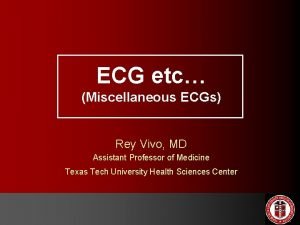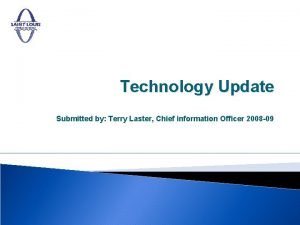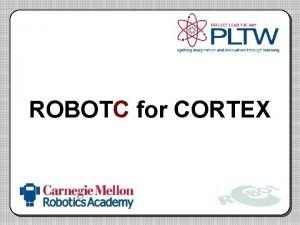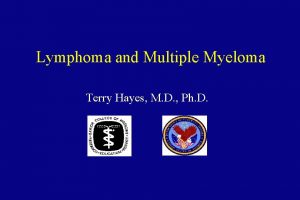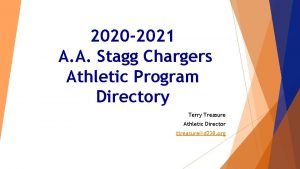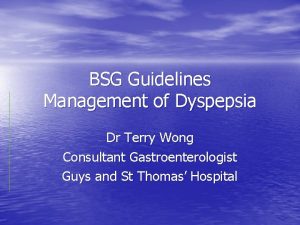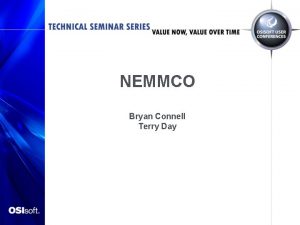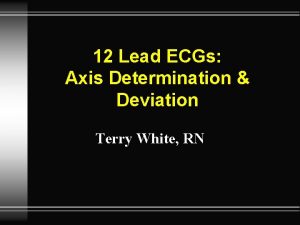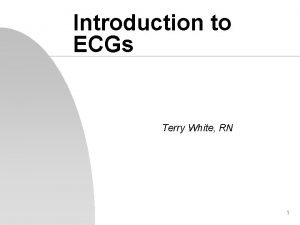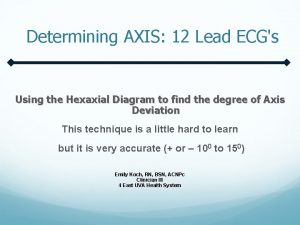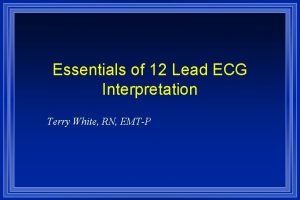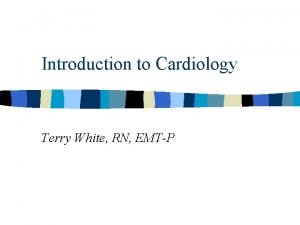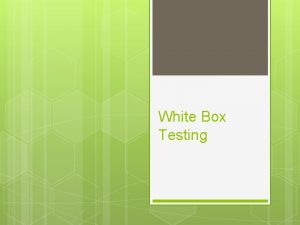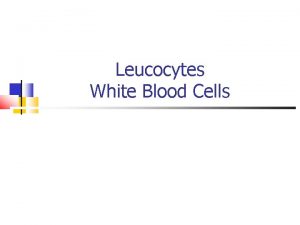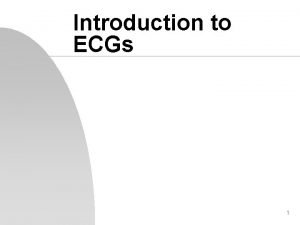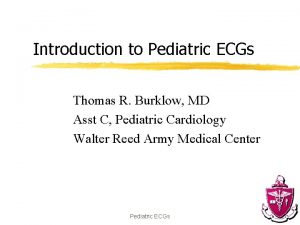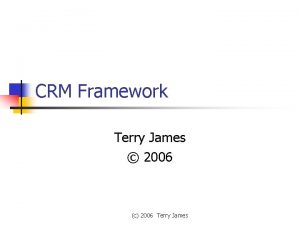Introduction to 12 Lead ECGs Terry White RN












































- Slides: 44

Introduction to 12 Lead ECGs Terry White, RN, EMT-P

Topics Why 12 Lead ECGs? l Critical Concepts in ACS l Monitoring vs Diagnostic ECGs l Acquisition & Transmission l

Why 12 Lead ECGs? l Demonstrated Advantages – Rapid Identification of Infarction/Injury • diagnosis made sooner in many cases – Decreased Time to Reperfusion Treatment • speeds preparation of & time to reperfusion therapies – Increased Index of Suspicion – Modification to Therapies

Why 12 Lead ECGs? l Perceived Disadvantages – Increased time spent on scene • demonstrated at 0 -4 min increase – Cost • equipment & training – No clinical advantage to patient & “our transport times are short” • demonstrated decrease in time to treatment • compare to early notification for trauma patients – Not helpful in “our system” • Possibly true!

Why 12 Lead ECGs? “The US National Heart Attack Alert Program recommends that EMS systems provide out-ofhospital 12 -lead ECGs to facilitate early identification of AMI and that all advanced lifesaving vehicles be able to transmit a 12 -lead ECG to the hospital” l American Heart Association in collaboration with International Liaison Committee on Resuscitation. Guidelines 2000 for Cardiopulmonary Resuscitation and Emergency Cardiovascular Care: International Consensus on Science, Part 7: The Era of Reperfusion. Circulation. 2000; 102 (suppl I): I-175.

Critical Concepts in ACS l Ischemia – lack of oxygenation – ST segment depression or T wave inversion l Injury – prolonged ischemia – ST segment elevation l Infarct – prolonged injury results in death of tissue – may or may not show Q wave

Critical Concepts in ACS l ST elevation - the key to the acute reperfusion therapy subset l You can’t see ST elevation without a 12 lead ECG – Perform on every patient suspected of ACS – Obtain early – Repeat frequently

Critical Concepts in ACS Will Infarct Occur? Collateral Circulation Plaque Rupture Tissue Death? Myocardial Oxygen Demand Thrombus Formation Coronary Vasoconstriction

Critical Concepts in ACS Chest pain or anginal equivalent suspicious of ischemia Immediate assessment and initial general treatment Assess initial ECG ST elevation or new BBB ST depression or T inversion Prepare and evaluate for reperfusion therapy Our Focus is Here! Fibrinolytics or primary PTCA Nondiagnostic - no STT deviation

Critical Concepts in ACS Acute Reperfusion Therapies l Fibrinolytics – Retaplase (r. PA) – Actiplase (t. PA) – Streptokinase (rarely used today) l Percutaneous Transluminal Coronary Angioplasty (PTCA) – Balloon angioplasty – Stent placement – Atherectomy

Critical Concepts in ACS Pain is Injury l Pain-Free is the Goal l Time is Muscle l Door to Reperfusion Therapy Time is the issue l

Monitoring vs Diagnostic ECGs l Extra wires – 3 wires vs 10 wires l Are there other differences?

Monitoring vs Diagnostic ECGs l Monitoring Quality ECG – Designed to provide information needed to determine rate and underlying rhythm – Designed to “filter out” artifact • Reduces the amount and degree of electrical activity seen by the ECG monitor

Monitoring vs Diagnostic ECGs Monitor Quality

Monitoring vs Diagnostic ECGs l Diagnostic Quality ECG – Designed to accurately reproduce QRS, ST and T waveforms – Designed to look more broadly at the cardiac electrical activity – Unfortunately, may result in greater artifact being visible

Monitoring vs Diagnostic ECGs Diagnostic Quality

Monitoring vs Diagnostic ECGs l Frequency Response – Term used to describe the breadth of the electrical spectrum viewed by the ECG monitor – Diagnostic quality is usually 0. 05 Hz to 150 Hz – Monitor quality is usually 0. 5 Hz to 20 -50 Hz – Usually printed on the ECG recording strip

Monitoring vs Diagnostic ECGs

Acquisition & Transmission l ECG quality begins with skin preparation and electrodes – Hair removal – Skin preparation – Age & Quality of Electrodes & Cables – Electrode Placement

Acquisition & Transmission l Hair Removal – Clipper over razor • Lessens risk of cuts • Quicker • Disposable blade clippers available – Most EMS systems use razors

Acquisition & Transmission

Acquisition & Transmission l. Skin Preparation – Helps obtain a strong signal – When measured from skin, heart’s electrical signal about 0. 0001 - 0. 003 volts – Skin oils reduce adhesion of electrode and hinder penetration of electrode gel – Dead, dried skin cells do not conduct well

Acquisition & Transmission Rubbing skin with a gauze pad can reduce skin oil and remove some of dead skin cells

Acquisition & Transmission l Other causes of artifact – Patient movement – Cable movement – Vehicle movement – Electromagnetic Interference (EMI)

Acquisition & Transmission l Patient Movement – Make patient as comfortable as possible • Supine preferred – Look for subtle movement • toe tapping, shivering – Look for muscle tension • hand grasping rail, head raised to “watch”

Acquisition & Transmission l Cable Movement – Enough “slack” in cables to avoid tugging on the electrodes – Many cables have clip that can attach to patient’s clothes or bed sheet

Acquisition & Transmission l Vehicle Movement – Acquisition in a moving vehicle is NOT recommended • May or may not be successful – Tips • Pull ambulance over for 10 -20 seconds during acquisition • Acquire ECG while stopped at traffic light

Acquisition & Transmission l Electromagnetic Interference (EMI) – Can interfere with electronic equipment – 60 cycle interference is a type of EMI – Look for nearby cell phones, radios or electrical devices – No contact between cables & power cords – Turn off or move away from AC devices – Use shielded cables; inspect for cracks

Acquisition & Transmission l Things to look for – Little or no artifact – Steady baseline

Acquisition & Transmission

Acquisition & Transmission l ECG Accuracy depends upon – Lead placement – Frequency response – Calibration – Paper speed

Limb Lead Placement Traditional Placement Avoid placing on the trunk!!! Acceptable Placement

Chest Lead Placement l l l V 1: fourth intercostal space to right of sternum V 2: fourth intercostal space to left of sternum V 3: directly between leads V 2 and V 4: fifth intercostal space at left midclavicular line V 5: level with V 4 at left anterior axillary line V 6: level with V 5 at left midaxillary line

Chest Lead Placement

ECG Accuracy Look for: l Negative a. VR – if a. VR upright, look for reversed leads One complete cardiac cycle in each lead l Diagnostic frequency response l Proper calibration l Appropriate speed l

ECG Accuracy l Frequency Response – Display screen is non-diagnostic – Use the printed ECG for ST segment analysis

ECG Accuracy l Calibration – Voltage measured vertically – Each 1 mm box = 0. 1 m. V – 1 m. V = 10 mm • calibration standard – Confirm calibration • calibration impulse should be 10 mm (2 big boxes tall) • stated calibration should be “x 1. 0”

Calibration

ECG Accuracy l Paper Speed – Standard is 25 mm/sec • Faster paper speed means the rhythm will appear slower and the QRS wider • Slower paper speed means the rhythm will appear faster and the QRS narrower

Paper Speed

When to Acquire Note times and differences in these two ECGs for the same patient

When to Acquire Assessment Treatment Vital Signs Oxygen Saturation Aspirin IV Access Nitroglycerin 12 -Lead ECG Morphine Brief History Modified from “The Ischemic Chest Pain Algorithm”, ACLS Textbook, Chapter 9, American Heart Association, 1997.

Exposing the Chest Immediately upon suspecting ACS. . . l Remove all clothing above the waist – Or, open shirt/blouse l Replace with gown (if possible) – Allows for complete exam – Minimizes wire entanglement – Enhances quick defib if VF occurs

Transmission l Transmit as soon as possible – Can use patient’s land-line – Many EMS systems use cell phone enroute l Coordinate with ED – Correlate ECG with a specific patient – Early notification of AMI is key!!!
 Ecgs
Ecgs Frequency dependence of dielectric constant
Frequency dependence of dielectric constant Nnn poem
Nnn poem Ellen g white biography
Ellen g white biography Maxine caroll lawrence
Maxine caroll lawrence Terry goh
Terry goh Terry stop
Terry stop Supreme x terry richardson
Supreme x terry richardson Maya nazon
Maya nazon Terry fox elementary school
Terry fox elementary school Teori pengambilan keputusan
Teori pengambilan keputusan Terry laster
Terry laster Robotc commands list
Robotc commands list Terry eagleton what is a novel
Terry eagleton what is a novel Kaley jay terry
Kaley jay terry Terry betts
Terry betts Terry hayes md
Terry hayes md Dr terry weaver
Dr terry weaver We finally arrived at your destination
We finally arrived at your destination Bronze star by irwin keene
Bronze star by irwin keene Dr terry correll
Dr terry correll Terry tadlock
Terry tadlock Terry biddington
Terry biddington Name 5 pieces of equipment unique to pedicures
Name 5 pieces of equipment unique to pedicures Types of ergonomics
Types of ergonomics Marty strus stagg
Marty strus stagg They said she would go yesterday
They said she would go yesterday Viessmann manufacturing company inc.
Viessmann manufacturing company inc. Terry fox essay
Terry fox essay The basketball player by terry rudder genre
The basketball player by terry rudder genre Hill's strategy development framework
Hill's strategy development framework Nttml -10v3
Nttml -10v3 Terry gage
Terry gage Mary austin fecha de nacimiento
Mary austin fecha de nacimiento Ken wilber terry killam
Ken wilber terry killam Terry landscaping & lawn care
Terry landscaping & lawn care Terry goh singapore
Terry goh singapore Dasar dasar pengambilan keputusan menurut george r terry
Dasar dasar pengambilan keputusan menurut george r terry Dr. terry wong
Dr. terry wong Terry roe
Terry roe Terry michler
Terry michler National terry day
National terry day Iss
Iss Terry marsh finance
Terry marsh finance Terry curry msu
Terry curry msu
